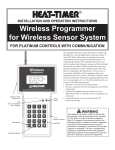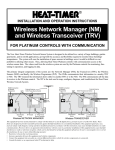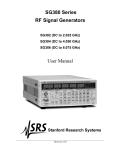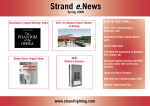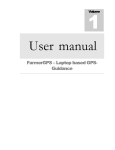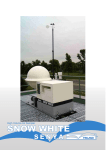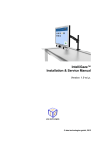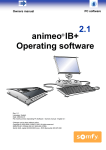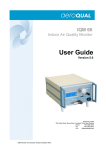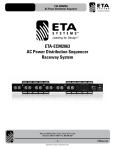Download INSTALLATION/OPERATING INSTRUCTIONS
Transcript
INSTALLATION/OPERATING INSTRUCTIONS SMC Snow Melt Control for Under Slab Heating Systems Table of Contents Understanding the SMC......................................................................................................pg. 2 SMC Control Panel..............................................................................................................pg. 3 Installation..........................................................................................................................pg. 4 Wiring Diagrams........................................................................................................pg. 5 Mounting the Control..................................................................................................pg. 9 Dip Switch Settings...................................................................................................pg. 9 Installing the Sensors...............................................................................................pg. 10 Wiring.....................................................................................................................pg. 11 Initial Settings..........................................................................................................pg. 13 Control Settings.................................................................................................................pg. 14 Winter/Summer Switch.............................................................................................pg. 14 Warm Weather Cutoff and Idle Set Point....................................................................pg. 14 Cold Weather Cutoff..................................................................................................pg. 14 Water Sensor Sensitivity...........................................................................................pg. 15 Minimum Boiler Return (Reaction Time)......................................................................pg. 15 Reaction Time..........................................................................................................pg. 15 ∆ T Max Slab Loop...................................................................................................pg. 15 Minimum On Time....................................................................................................pg. 16 Maximum Slab Supply Temperature...........................................................................pg. 16 Alarm......................................................................................................................pg. 17 Display Choices.......................................................................................................pg. 17 References........................................................................................................................pg. 18 Specifications..........................................................................................................pg. 18 Meaning of Lights.....................................................................................................pg. 18 Error Messages.......................................................................................................pg. 19 Checking Sensors....................................................................................................pg. 20 CORPORATION 20 New Dutch Lane, Fairfield, NJ 07004 973-575-4004 • FAX 973-575-4052 http://www.heat-timer.com HT #059158 REV B 1 UNDERSTANDING THE SNOW MELT CONTROL The Heat-Timer Snow Melt Control (SMC) is designed to control under slab heating systems which prevent accumulation of snow and ice on sidewalks, driveways, and other areas where buildups are undesirable. This is accomplished in two steps. First, the temperature and moisture of the slab are continuously monitored. Second, when moisture is detected and the temperature suggests there could be ice or snow, the heating system is activated and continues to run until the moisture is evaporated. The snow sensor is designed to become an integral part of the slab it will monitor. Therefore, it is specifically engineered for the extremes of heat and cold to which it will be subjected. Also, the sensor will withstand pressure and impact, such as might occur when a car drives over it. Despite this sturdy structure, the snow sensor will be able to read slab temperature within one degree, and sense even trace amounts of moisture. The snow sensor provides the information necessary to run the slab heating system. This system generally will include a heating plant, a heat exchanger, and a pump to move anti-freeze solution through the slab itself. The SMC can regulate the temperature of the anti-freeze solution to the slab by one of the following methods: • Modulating a 3-way valve to mix hot solution with solution returning from the slab • Modulating a 2-way valve to control the amount of steam entering the heat exchanger • Controlling a sequencing panel (SEQ6, SEQ6P or SEQ12) to stage multiple burners Typical application schematics are shown on pages 5-8. Whenever the outdoor temperature falls below the adjustable Warm Weather Cutoff, the heating plant will be activated. At this point, the slab will be warmed to an idle temperature by pumping warm anti-freeze solution through it. This will give the slab a head start on melting should precipitation occur. Once moisture is detected, the slab will be raised to an adjustable operating temperature. The temperature of the solution going to the slab is monitored to insure that at no time does too much heat enter the slab, causing stress on the slab and its components. The SMC includes several other features. The heating plant return temperature is monitored to reduce the possibility of thermal shock to the boiler. Also, an alarm is activated when any sensor fails to read correctly, if the slab is not receiving heat, and if the slab can not get up to temperature in 24 hours. 2 MODEL SMC To help simplify these instructions, sections of the control panel are keyed and referred to in the text by the following numbers. 4 CURRENT STATUS INDICATORS 0 10 F MELTING 1 SNOW MELT CONTROL 0 0 20 F 0F COLD WEATHER CUTOFF ALARM SURFACE WATER DETECTED ACTIVE 2 5 °F °F WARM WEATHER CUTOFF IDLE SET POINT 7 NORMAL 0 L E S S F SLAB TEMP. M O R E PRESS TO DISPLAY SLAB SUPPLY WINTER WATER SENSOR SENSITIVITY V ACTIVE MODEL SMC 15 F 5F N.J. FAIRFIELD, 0 0 IDLING SERIAL NO. T SLAB LOOP BOILER RETURN 6 SUMMER MADE IN U.S.A. LR 92903 R ATTENTION! LE CABLAGE RACCORDE DANS BOITE DOIT CONVENIR POUR UNE TENSION NOMINALE D'AU MOINS 120V CAUTION! W IRING IN THIS BOX MUST BE RATED AT LEAST 120V SLAB PUMP BURNER 3 8 SLAB VALVE OPEN CLOSE ALARM ALARM RESET 80 30 100 R TEMPERATURE REGULATING EQUIPMENT LISTED 723E 9 OUTPUT RELAYS 20 60 120 40 140°F MINIMUM BOILER RETURN TEMP 40 50°F 10 T MAXIMUM MINIMUM ON TIME 5 6 7 8 9 11 10 12 13 14 15 0 16 2 INPUT TERMINALS BRN BLK WHT GRN RED TO SNOW SENSOR SUPPLY PUMP OR VALVE CLASS I WIRING ONLY SUPPLY 115V 60HZ POWER CONSUMPTION 20VA MAX. BURNER SLAB PUMP ALARM OUTPUTS: 120VAC, 6A RESISTIVE; 1A PILOT DUTY 15A TOTAL FOR ALL CIRCUITS CLOSE OPEN SLAB VALVE DO NOT APPLY ANY VOLTAGE TO THESE TERMINALS ROUTE SENSOR AND USE COPPER WIRE ONLY 3 4 COMM LINE MUST BE CONNECTED NEUTRAL OUTPUT TERMINALS 1 AUXILIARY WIRES THROUGH THIS KNOCKOUT ONLY 425063-00 REV A 4 BOILER RETURN 3 SLAB RETURN 2 SLAB SUPPLY 1 GETTING THE INSTALLATION STARTED Following are four typical application schematics: • SMC with 3-way Valve and Heat Exchanger • SMC with 3-way Valve (Anti-freeze solution runs directly into the boiler) • SMC with Steam to Hot Water Heat Exchanger • SMC controlling a Sequencing Panel SEQ6, 6P or 12 (Anti-freeze solution runs directly into the boilers) Select the schematic which matches your application. If none of the schematics match your application, contact the factory for further assistance. NOTE: The application schematics are for illustration purposes only. They do not represent complete system diagrams and can not be interpreted as such. Installation of this control is simple if you follow the instructions carefully. The installation consists of four basic steps: • • • • Locating and mounting the control Locating and mounting the sensors Wiring the power, input and output lines Creating an initial pilot program of settings WARNING The Heat-Timer Model SMC is strictly an operating control; under no circumstances should it be used as a primary limit or safety control. The system must have its own certified limit and safety controls required by local codes. These are the responsibility of the installing contractor who must verify proper operation and correct any safety problems prior to starting the SMC installation. 4 MUST BE CONNECTED 1 3 °F 2 WARM WEATHER CUTOFF ACTIVE 5 SUPPLY PUMP OR VALVE 4 °F 6 8 BURNER 7 BURNER IDLE SET POINT ALARM IDLING MELTING 9 SLAB PUMP SLAB PUMP 10 11 PRESS TO DISPLAY ACTIVE 13 T SLAB LOOP 15 16 CLOSE OPEN SLAB VALVE 14 CLOSE OPEN SLAB VALVE MADE IN U.S.A. SUMMER ALARM 12 ALARM WINTER SLAB SUPPLY 20 F 0 15 F 0 BOILER RETURN BLK DF NORMAL GRN 1 RED 2 4 ROUTE SENSOR AND 10 20 50°F 40 T MAXIMUM 30 MINIMUM ON TIME MINIMUM BOILER RETURN TEMP 140DF 100 ALARM RESET SENSITIVITY 40 0 M O R E WATER SENSOR L E S S DETECTED SURFACE WATER 120 TO SNOW SENSOR WHT SMC N.J. SNOW MELT CONTROL 60 80 SERIAL NO. FAIRFIELD, THIS KNOCKOUT ONLY AUXILIARY WIRES THROUGH DO NOT APPLY ANY VOLTAGE TO THESE TERMINALS BRN SLAB TEMP. COLD WEATHER CUTOFF 0F 0 5F 0 COMM 0 SLAB SUPPLY 10 F SLAB RETURN CURRENT STATUS INDICATORS NEUTRAL LINE SNOW/ICE SENSOR SLAB SUPPLY SENSOR SLAB RETURN BOILER RETURN TERM 9-10 TERM 4-5 TERM 7-8 TERM 14-15-16 BURNER BOILER RETURN SENSOR HEAT EXCHANGER SLAB RETURN SENSOR SENSOR SUPPLY 3-WAY MIXING VALVE SMC with 3-way Valve and Heat Exchanger BOILER RETURN V 5 SLAB SNOW/ICE SENSOR MUST BE CONNECTED 1 3 °F 2 WARM WEATHER CUTOFF ACTIVE 5 SUPPLY PUMP OR VALVE 4 °F 6 8 BURNER 7 BURNER IDLE SET POINT ALARM IDLING MELTING 9 SLAB PUMP SLAB PUMP 10 11 PRESS TO DISPLAY ACTIVE 13 T SLAB LOOP 15 16 CLOSE OPEN SLAB VALVE 14 CLOSE 0 20 F OPEN SLAB VALVE MADE IN U.S.A. SUMMER ALARM 12 ALARM WINTER SLAB SUPPLY 0 15 F BOILER RETURN BLK DF 140DF 100 GRN RED 2 4 ROUTE SENSOR AND 10 20 50°F 40 T MAXIMUM 30 MINIMUM ON TIME MINIMUM BOILER RETURN TEMP 1 M O R E ALARM RESET 40 TO SNOW SENSOR WHT NORMAL WATER SENSOR SENSITIVITY L E S S SURFACE WATER DETECTED 120 0 N.J. SNOW MELT CONTROL SMC 60 80 SERIAL NO. FAIRFIELD, THIS KNOCKOUT ONLY AUXILIARY WIRES THROUGH DO NOT APPLY ANY VOLTAGE TO THESE TERMINALS BRN SLAB TEMP. COLD WEATHER CUTOFF 0 0F 0 5F COMM 0 SLAB SUPPLY 10 F SLAB RETURN CURRENT STATUS INDICATORS NEUTRAL LINE SNOW/ICE SENSOR SLAB SUPPLY SENSOR SLAB RETURN BOILER RETURN TERM 4-5 TERM 9-10 TERM 7-8 TERM 14-15-16 SENSOR BOILER RETURN 3-WAY MIXING VALVE SMC with 3-way Valve BOILER RETURN V 6 BURNER SUPPLY SLAB RETURN SENSOR SLAB SENSOR SNOW/ICE SENSOR MUST BE CONNECTED 1 3 °F 2 WARM WEATHER CUTOFF ACTIVE 5 SUPPLY PUMP OR VALVE 4 °F 6 8 BURNER 7 BURNER IDLE SET POINT ALARM IDLING MELTING 9 SLAB PUMP SLAB PUMP 10 11 13 0 0F 0 20 F 0 15 F PRESS TO DISPLAY ACTIVE 15 16 CLOSE OPEN SLAB VALVE 14 CLOSE OPEN SLAB VALVE MADE IN U.S.A. T SLAB LOOP BOILER RETURN BLK DF 140DF 100 GRN RED 2 4 ROUTE SENSOR AND 10 20 50°F 40 T MAXIMUM 30 MINIMUM ON TIME MINIMUM BOILER RETURN TEMP 1 M O R E ALARM RESET SENSITIVITY 40 TO SNOW SENSOR WHT NORMAL WATER SENSOR L E S S DETECTED SURFACE WATER 120 0 N.J. SNOW MELT CONTROL SMC 60 80 SERIAL NO. FAIRFIELD, SLAB RETURN TERM 9-10 TERM 7-8 TERM 14-15-16 SNOW/ICE SENSOR SLAB SUPPLY SENSOR THIS KNOCKOUT ONLY AUXILIARY WIRES THROUGH DO NOT APPLY ANY VOLTAGE TO THESE TERMINALS BRN SLAB TEMP. COLD WEATHER CUTOFF SUMMER ALARM 12 ALARM WINTER SLAB SUPPLY 0 5F COMM 0 SLAB SUPPLY 10 F SLAB RETURN CURRENT STATUS INDICATORS NEUTRAL LINE 1K Ohm to COM BURNER HEAT EXCHANGER ( "V" PORT) STEAM VALVE MODULATING SENSOR RETURN SLAB SENSOR SUPPLY SMC with Steam to Hot Water Heat Exchanger BOILER RETURN V 7 SENSOR SNOW/ICE SLAB °F 1 3 NEUTRAL 2 LINE WARM WEATHER CUTOFF ACTIVE 5 °F 6 8 BURNER 7 BURNER IDLE SET POINT SUPPLY PUMP OR VALVE 4 ALARM IDLING MELTING 9 SLAB PUMP 11 13 15 16 CLOSE OPEN SLAB VALVE 14 CLOSE OPEN SLAB VALVE MADE IN U.S.A. SLAB LOOP T PRESS TO DISPLAY ACTIVE SUMMER ALARM 12 ALARM WINTER SLAB PUMP 10 SLAB SUPPLY 0 20 F RETURN BOILER BLK DF GRN 1 RED 2 4 10 20 ROUTE SENSOR AND TERM 16 AUXILIARY WIRES THROUGH THIS KNOCKOUT ONLY 1K Ohm to COM TERM 5 TERM 4 40 TERM 15 TERM 14 50°F T MAXIMUM 30 MINIMUM ON TIME MINIMUM BOILER RETURN TEMP 120 0 M O R E ALARM RESET 140DF 100 SENSITIVITY 40 TO SNOW SENSOR WHT NORMAL WATER SENSOR L E S S DETECTED SURFACE WATER 60 80 N.J. SNOW MELT CONTROL SMC FAIRFIELD, SERIAL NO. DO NOT APPLY ANY VOLTAGE TO THESE TERMINALS BRN SLAB TEMP. COLD WEATHER CUTOFF 0F 0 0 15 F 10 F 0 5F COMM 0 SLAB SUPPLY CURRENT STATUS INDICATORS SLAB RETURN Dry Contact Only 8 7 COM 6 SENSOR 5 +4 SHIELD 3 COM 2 SENSOR 1 SNOW/ICE SENSOR SLAB SUPPLY SENSOR SLAB RETURN LEAD STAGE 6 STAGE SEQUENCER SEQ-6 PRESS TO READ TURN TO ADJUST LEAD PUMP STAGE 6 STAGE 5 STAGE 4 STAGE 3 STAGE 2 STAGE 1 ACTIVE K1 K11 K12 K13 G H N PUMP STAGE 6 STAGE 5 STAGE 4 STAGE 3 STAGE 2 STAGE 1 TERM 9 - 10 BURNER BURNER BURNER SENSOR SLAB RETURN SENSOR SUPPLY SENSOR SNOW/ICE SLAB SMC Controlling a Sequencing Panel: SEQ6, SEQ6P or SEQ12 Shown with 3 ON/OFF Boilers BOILER RETURN TEMP V 8 PRESSURE 60 Hz SHUTDOWN 120 VAC IN FIRST STEP: MOUNT THE CONTROL Locate the control in an available site away from extreme heat and cold. The most logical place is in the mechanical equipment room or in an adjacent supervisory room, but away from any boilers and never in direct contact with a boiler or other hot surfaces. Avoid high temperatures: The control must be kept away from high temperatures. A location where room temperatures prevail is most preferable. Keep it unobtrusive: Avoid sites that are too public, where it might draw unwanted attention and tempt tampering. Keep it at eye level: Place it at about eye level so that the controls and signals are convenient to the operator. Once a location has been decided upon, find a suitable surface on which to mount the case. Mounting holes are provided on the back of the enclosure; but first you must remove the control panel in order to gain access to them. Use the following steps: 1. Take off the gutter cover by loosening the screws at its bottom. 2. Detach the control panel by removing the screw at the top center and loosening the two bottom ones. 3. With the panel out, you are free to mount the enclosure, using the mounting holes on the back of the case. 4. Mount the enclosure, using appropriate screws. Stop Here: Set the Back of the Panel Now while the control panel is out of the case is the time to activate the battery. Remove the battery insulation sheet by grasping the protruding end and pulling it out. This 5-year lithium battery is located on the back of the panel at its very top. Once activated it secures the control’s memory in case of a power outage. However, do not activate the battery unless you intend to power the control at once. It will drain down in about 100 days unless the control is powered. Set the dip switch for your application as shown below. Dip Switch Settings ON 1 2 3 4 5 6 7 Switches 1 through 5 Switch 8 Must be OFF Not Used Switch 6 Cold Weather Cutoff ON Switch 7 Sequencer Enable ON Direct Control Mode Enabled 6 7 ON ON Interface to SEQ6, SEQ6P, or SEQ12 Disabled 6 8 7 9 SECOND STEP: MOUNT THE SENSORS Install the Snow Sensor The location of the snow sensor (HT part #904200) must be carefully considered when the slab is being prepared or poured. The sensor should be placed in a location which represents the temperature of the majority of the slab. It should be placed away from any buildings, vents, or other heat sources. Also avoid placing the snow sensor in a sunny area when most of the slab is in shade, or vice versa. Another consideration when choosing the sensor location is to select a site where moisture is neither likely to run off or to puddle up. In the case of an area where the water runs off, the heating system will not run long enough to evaporate the majority of the water. In the case of the sensor being in a puddle, the heating system will have to run longer than necessary to detect that moisture has been evaporated. An exception to this later rule would be when the sensor site is specifically chosen to prevent snow or ice buildup in a known problem area. Equally importantly, the snow sensor must be level. If it is not, moisture will drain off the sensor and detection will not accurately occur. Also, a separate conduit should be run from the sensor location to the panel to house the sensor wires. This will provide easy access to the wires for service. These wires should not be run in conduit with any line voltage or other signal wires. Place the sensor socket in the chosen location and run the conduit feed to it. If more than 100 ft of wire is needed to reach the control panel location, install an appropriate junction box along the way. (Up to 400 ft of 14 gauge wire may be added to the supplied wire). Support the socket with a block of rock or stone to give it stability and level the surface of the dummy plug with the finished grade. (The plug has the same dimension as the snow sensor). After the concrete has cured, remove the plug and install the snow sensor using the o-ring and screws provided. Leave 6-12" of wire in the socket cavity. Caution: The snow sensor is located outdoors and is likely to become covered with dirt, salt, or other substances which will adversely affect the moisture sensitivity of the sensor. It is important to check the snow sensor periodically to insure the surface of the sensor is clean. If the sensor is dirty, wipe or brush off the surface until the Heat-Timer logo and all other metal surfaces are clear. Install the Slab Supply and Slab Return Sensor The slab supply and return sensors must be immersion type sensors. These sensors will provide fast accurate information on changes in slab heating temperatures since they will be immersed in the anti-freeze solution. Make sure the supply sensor is approximately ten feet downstream from the heat source to avoid temperature fluctuations. The slab return sensor can be installed in any convenient location where the anti-freeze solution has returned from the slab. The immersions sensors (HT part #904024) thread into any existing 1/2"NPT, 3/8" I.D. well. If there are no existing wells, then it is necessary to install a well (HT part #904001) in both the slab supply and slab return. The wires for the immersion sensor can be extended up to 500' by simply splicing to the existing wire. Caution: Use shielded 2-conductor cable (#22 AWG minimum or to meet local codes) Belden #8760 shielded cable or equivalent. Avoid running the sensor wires in the same conduit with line voltage wiring. Install the Boiler Return Sensor Monitoring the return temperature to the boiler will help to preventing thermal shock stress to the boiler. This sensor should be an immersion type sensor (HT part #904024) and be installed in the same manner as the slab supply and return sensors (described above). WARNING If the Boiler Return Sensor is not being installed, it is necessary to place a 1,000 Ohm (1KΩ) resistor from the terminal BOILER RETURN to COM. If this resistor is not installed, the alarm output will constantly be activated and the slab pumps will shut down. 10 THIRD STEP: WIRE THE TERMINALS Wiring the Power Terminal #1 is for earth ground. It must be connected. Terminal #2 is for line voltage and #3 is for neutral. Wiring the SUPPLY PUMP OR VALVE and BURNER (Without SEQ panel) First check the typical application drawings (pgs. 5-8) to determine which outputs should be connected for your application. Terminals #7 and #8 are normally open and should be wired in series with the limit circuit of the burner. If connecting to a supply pump, wire Terminals #4 and #5 to the pump starter. If connecting to a valve, Terminal #5 is common, Terminal #4 is open, and Terminal #6 is close. NOTE: Terminals #4 through #8 are all controlled by the BURNER RELAY. They are DRY CONTACTS only. When the BURNER RELAY closes, #4 and #5 will close, as will #7 and #8. The normally closed contacts #5 and #6 will open. The relay is rated for 6A at 120VAC. Wiring the SLAB PUMP Wire Terminals #9 and #10 to the slab pump starter. NOTE: Terminals #9, #10, and #11 provide a normally open and normally closed output. They are DRY CONTACTS ONLY. These are controlled by the SLAB PUMP RELAY. The relay is rated for 6A at 120VAC. Wiring the SLAB VALVE (Without SEQ panel) Terminals #14, #15, and #16 provide floating control for the slab temperature control valve. This output can modulate either a 2-way or a 3-way control valve (see pgs. 5-8 for typical applications). NOTE: These connections are controlled by the SLAB VALVE CLOSE and the SLAB VALVE OPEN RELAYS. They are DRY CONTACTS ONLY. The relays are rated for 6A at 120VAC. Wiring to a SEQ panel (SEQ6, SEQ6P or SEQ12) SMC Output Terminal 14 15 4 5 16 Connect To SEQ Input Terminal 1 2 5 6 7 Wiring the ALARM Terminals #12 and #13 are normally open contacts to run an alarm if the slab does not get heat, if the slab does not reach temperature in 24 hours, or if there is a fault in a sensor. NOTE: These contacts are controlled by the ALARM RELAY. They are DRY CONTACTS ONLY. The relay is rated for 6A at 120VAC. Wiring Guidelines Bring wires through “knock-out” holes at the bottom of the enclosure. Do not attempt to bring wires in from the sides or top - this will interfere with the servicing of the control. Use electrical connectors such as you use with any junction box. Copper wire is specifically required by UL. Make sure the 120V line has a circuit breaker of its own. Caution: Choose a 120V power source with nothing else on the line. Do not put the control on the same line with the boiler power or other switches. This could result in the control being disconnected. The amount of current switched by the output relays must not exceed 1 amp inductive, 6 amps resistive at 120V. Comply with local codes, inserting external over-current protection. Make sure suitable branch circuit protection is provided. 11 And Now: Wire the Input Terminals (Class 2) The class 2 terminals are for connecting the control to the snow sensor and the other temperature sensors. WARNING Never apply external voltage to the input terminals for the Snow Sensor, the Slab Supply, the Slab Return, or the Boiler Return. Permanent damage will occur, voiding the warranty. Draw the wires from the Snow Sensor and other temperature sensors through the knockout holes directly under the terminals on the right side of the case and connect them to the appropriate terminal lugs described below. Always use the knock-out holes. The snow sensor wires go to the left five terminals. Connect the colored wires to the marked terminals, that is the brown wire to BRN, the black wire to BLK, the white wire to WHT, and green wire to GRN, and the red wire to RED. For the remaining three sensors (only two if the boiler return is not being monitored), one side of each sensor wire must go the terminal marked COM or BLK. The other wire from the slab supply sensor goes to the terminal marked SLAB SUPPLY. The other wire from the slab return sensor goes to the terminal marked SLAB RETURN. Finally, the other wire from the boiler return sensor goes to the terminal marked BOILER RETURN. WARNING If the Boiler Return Sensor is not being installed, it is necessary to place a 1KΩ resistor from the terminal BOILER RETURN to COM. If this resistor is not installed, the alarm output will constantly be activated and the slab pumps will shut down. Installation Tests for Sensor Wiring About 15 to 30 seconds after the control is powered, the slab temperature should appear on the display. If the display reads OPN this means the SMC does not see the snow sensor connected. This could mean that the snow sensor has not been hooked to the correct terminals or that there is a break or OPeN somewhere in the run of the wires to the terminals. If the display reads SHT this means the SMC sees a SHorT in the wires connected to the sensor. (See References pg. 20 for more information on testing sensors). To test the slab supply sensor, first be sure the Winter/Summer switch (Box 6 on pg. 3) is in the Winter position. Then push the button marked SLAB SUPPLY (Box 6). The display will show the temperature reading recorded by the SLAB SUPPLY sensor. As with the slab temperature sensor, an OPN or SHT in the display indicates there is a problem with the sensor. To test the slab return sensor, push the button marked ∆T SLAB LOOP (Box 6). If both the slab supply and slab return sensor have a valid readings, then the difference between the supply and return will be shown. Otherwise, the display will show —. Therefore, if the slab supply sensor shows a valid reading and the display shows — then there is a problem with the slab return sensor. Finally, to test the boiler return sensor, if it is being used, push the button marked BOILER RETURN (Box 6). If an OPN or SHT is displayed, there is a problem with the sensor. NOTE: If the boiler return sensor is not being used, a 1KΩ resistor must be placed across the terminals BOILER RETURN and COM. This 1KΩ resistor will display approximately 150°F when the button BOILER RETURN is pushed and held. 12 FINAL STEP: INITIALIZING SETTINGS Once the control is mounted and wired, the next step is to get an initial program set. The following settings are recommended as a start-up program. The Control settings section (pg. 14) describes each setting in more detail. (The Box numbers referenced refer to the front panel diagram on pg. 3.) Initial Start-Up Settings (Without SEQ panel) 1. Winter/Summer switch (Box 6) - set to Winter. 2. Warm Weather Cutoff and Idle Set Point (Box 2)- The Warm Weather Cutoff should be set at 38° and the Idle Set Point set to 34°. 3. Cold Weather Cutoff (Box 4) - set to 20°F. 4. Water Sensor Sensitivity (Box 7)- Select the NORMAL position. If the red light marked Surface Water Detected (Box 7, directly above the knob) is on when there is no precipitation, then check the snow sensor and make sure it is clean. 5. Minimum Boiler Return Temperature (Box 9) - This should be set according to the boiler manufacturers specifications. A safe starting point would be 140° unless the manufacturer specifies a lower return. 6. ∆T Maximum Slab Loop (Box 9) - set to 20°F or check slab design characteristics to see if a higher ∆T can be selected. 7. Minimum On Time (Box 9) - Set to 1 hour of run. 8. Maximum Slab Supply - This should be set to the maximum temperature specified for the slab and/or tubing. To adjust the temperature, move the Winter/Summer switch (Box 6) to the Summer position and push and hold the SLAB SUPPLY button (also in Box 6). The SLAB TEMP display (Box 5) will show the Maximum Slab Supply set point. Adjust either the Warm Weather Cutoff or the Idle Set Point knob (while continuing to hold the SLAB SUPPLY button) to change the Maximum Slab Supply set point. When the desired temperature is displayed, release the SLAB SUPPLY button and switch the Winter/Summer switch back to Winter. Initial Start-Up Settings (With SEQ panel) To work with an SEQ output panel, Dip Switch 7 must be ON (see pg. 9). 1. Winter/Summer switch (Box 6) - set to Winter. 2. Warm Weather Cutoff and Idle Set Point (Box 2)- The Warm Weather Cutoff should be set at 38° and the Idle Set Point set to 34°. 3. Cold Weather Cutoff (Box 4) - set to 20°F. 4. Water Sensor Sensitivity (Box 7)- Select the NORMAL position. If the red light marked Surface Water Detected (Box 7, directly above the knob) is on when there is no precipitation, then check the snow sensor and make sure it is clean. 5. Minimum Boiler Return Temperature (Box 9) - The function of this knob changes when interfacing to a SEQ panel. The knob becomes a Reaction Time adjustment. The Reaction time is the time between output stages being turned on or off. In the fully counterclockwise position, the Reaction time will be 1 minute. In the fully clockwise position, the Reaction time will be 10 minutes. Set the initial Reaction time to approximately 3 minutes or the position of the knob marked 60. 6. ∆T Maximum Slab Loop (Box 9) - set to 20°F or check slab design characteristics to see if a higher ∆T can be selected. 7. Minimum On Time (Box 9) - Set to 1 hour of run. 8. Maximum Slab Supply - This should be set to the maximum temperature specified for the slab and/or tubing. To adjust the temperature, move the Winter/Summer switch (Box 6) to the Summer position and push and hold the SLAB SUPPLY button (also in Box 6). The SLAB TEMP display (Box 5) will show the Maximum Slab Supply set point. Adjust either the Warm Weather Cutoff or the Idle Set Point knob (while continuing to hold the SLAB SUPPLY button) to change the Maximum Slab Supply set point. When the desired temperature is displayed, release the SLAB SUPPLY button and switch the Winter/Summer switch back to Winter. WARNING If high temperatures will damage the slab or the slab components, a separate high limit controller must be installed to shut down the heating system if excessively high temperatures are being supplied to the slab. 13 CONTROL SETTINGS The “start-up” list on the previous page serves to help you with a quick but incomplete guide to getting the control’s initial settings under way. All settings are keyed by number to correspond to the “start-up” list. All Box numbers refer to the front panel diagram on page 3. Here, on the following pages, are more detailed instructions on programming your SMC. You should learn the purpose and operation of each element of the control. 1. WINTER/SUMMER SWITCH The winter-summer switch (in Box 6) must be in the WINTER position for the SMC to operate. The switch is used to turn the control off in summer while leaving displays active and preventing the back-up battery from draining down. 2. WARM WEATHER CUTOFF AND IDLE SET POINT The Warm Weather Cutoff (in Box 2) actually performs two functions. When melting is not occurring, the Warm Weather Cutoff acts as an upper limit. If the slab temperature is warmer than the Warm Weather Cutoff, then melting will not begin even when moisture is detected. When the slab temperature falls below the Warm Weather Cutoff then the heating system will hold the slab at the Idle Set Point temperature until moisture is detected. A ±1F° differential is included in the Warm Weather Cutoff. This means that if the Warm Weather Cutoff is set for 38°F, the slab temperature must fall to 37°F before the heating system is activated. The heating system will remain activated until the slab temperature reaches 39°F. Once moisture has been detected and the slab temperature is below the Warm Weather Cutoff, melting begins. At this point, the Warm Weather Cutoff will serve as the set point at which the slab temperature will be held. That is, using the previous example, once a melting cycle has begun, the SMC will maintain the slab at 38° until the moisture is evaporated, or the minimum run time is exceeded, whichever comes last. The Idle Set Point is the temperature at which the slab will be held whenever melting is not occurring and the slab temperature is below the Warm Weather Cutoff. The Idle Set Point can be turned OFF, so the slab is not heated unless moisture is detected. The Idle Set Point can never be set higher than the Warm Weather Cutoff. If one attempts to raise the Idle Set Point above the Warm Weather Cutoff the display will not rise above the Warm Weather Cutoff. Therefore, to raise the Idle Set Point, it may first be necessary to raise the Warm Weather Cutoff. The range for the Warm Weather Cutoff is from 34°F to 44°F. The Idle Set Point range is from 20°F to 44°F and also has an OFF position, indicated by —. When the slab temperature rises above the Warm Weather Cutoff the red Warm Weather Cutoff ACTIVE light (Box 2) will come on. 3. COLD WEATHER CUTOFF The Cold Weather Cutoff (in Box 4) prevents the slab from being heated when the slab temperature falls below a selected temperature. The setting for the Cutoff depends on two items, the size of the slab heating capacity and the type of precipitation that falls in colder weather. The limiting factor on the Cold Weather Cutoff must be the capacity of the system installed in the slab. As the slab becomes colder, the cost of heating the slab may well become prohibitive, and it may be impossible to raise the slab temperature enough to melt precipitation. The Cold Weather Cutoff can be set from 0°F to 20°F. If you wish to disable the Cold Weather Cutoff under all conditions, set dip switch 6 (pg. 9). When the slab temperature falls below the Cutoff, the red Cold Weather Cutoff ACTIVE light will come on and remain on until the slab temperature rises above the Cutoff. There is a ±1F° differential built into the Cold Weather Cutoff. For example, if the Cold Weather Cutoff is set for 15°F then the Cutoff ACTIVE light will come on at 14°F and will remain on until the temperature reaches 16°F. 14 4. WATER SENSOR SENSITIVITY The Water Sensor Sensitivity knob (found in Box 7) adjusts the sensitivity of the snow sensor. The snow sensor is located outdoors and the surface must be kept clean. If it is not, the sensor may continuously detect moisture, even when none is present. The Water Sensor Sensitivity knob compensates for a dirty sensor. The SMC has several internal timers which delay the registering of moisture on the slab sensor when the SMC is switched to WINTER mode. Thus, even though the sensor has detected moisture, the red Surface Water Detected light may not come on immediately when the system is running. Therefore, when calibrating the Water Sensor sensitivity knob, switch the SMC into the Summer mode. In the Summer mode, the red Surface Water Detected light will not be delayed, and will turn on and off immediately based on the position of the knob and the information from the slab sensor. Once the Water Sensor Sensitivity knob has been calibrated, be sure to return the SMC into the Winter mode for proper operation. When moisture is detected by the snow sensor, the red LED marked SURFACE WATER DETECTED will light. This light should be used to test for the appropriate setting of the Water Sensor Sensitivity knob. If the snow sensor is known to be dry, then the LED should not be lit. Then when precipitation begins, the knob WATER SENSOR SENSITIVITY should be rotated very slowly clockwise from less to more sensitive until the LED lights up. NOTE: Once water has been detected on the slab, the SMC will “remember” this for four hours. That is, once moisture has been detected, if the slab temperature falls below the Warm Weather Cutoff or rises above the Cold Weather Cutoff, then melting will begin up to four hours after the moisture was detected. The fact that water has been detected will be shown by the red LED flashing. 5. MINIMUM BOILER RETURN TEMP (Without SEQ panel) The Minimum Boiler Return Temperature knob (found in Box 9) is designed to reduce thermal shock on the boiler. The thermal shock of cold water returning to a hot boiler may shorten the life of the boiler. To avoid this undesirable situation, the Minimum Boiler Return can be set from 40° to 140°. When the temperature from the heating loop falls below the Minimum Boiler Return, the SLAB VALVE and SLAB PUMP are shut down to stop the heat transfer out of the system and to allow the boiler to recover. Then as the return temperature rises, the slab heating system is reactivated. 5. REACTION TIME (SEQ panel) The knob marked Minimum Boiler Return Temperature (found in Box 9) changes function when the SMC is configured to control a SEQ panel (SEQ6, SEQ6P or SEQ12). To enter this mode, dip switch number 7 must be ON (see pg. 9). When the knob is turned fully counterclockwise, the Reaction Time is 1 minute. When the knob is turned fully counterclockwise, the Reaction Time is 10 minutes. In the center position (12 o’clock), the Reaction Time setting is 5.5 minutes. The Reaction Time controls the minimum run time for any stage. When a stage has been added, that stage can not be turned off, nor can another stage be activated, until at least half the Reaction Time has elapsed. The Reaction Time must be set to at least as long as the time it takes for a newly activated stage to start affecting the slab supply temperature. 6. ∆T MAXIMUM SLAB LOOP The ∆T Maximum Slab Loop (found in Box 9) is designed to prevent too much heat from entering the slab at one time. When the amount of energy transferred to the slab exceeds a safe limit, the slab may be damaged. The ∆T is determined at the time the slab heating system is designed. It is a function of the size of the slab, the size of the heating system pump, and the size and spacing of the slab heating coils. To prevent this excess energy transfer, the temperature of the heating solution going out to the slab (Slab Supply) and the temperature of the solution returning from the slab (Slab Return) is monitored. This information provides a rough 15 estimation of the amount of energy being transferred to the slab. The ∆T Maximum Slab Loop allows the operator to adjust the amount of energy entering the slab. The knob can be set from 10° to 50°F. When the difference between the Slab Supply and Slab Return exceeds this maximum value, the Slab Valve begins to close. The Slab Valve will close as much as is necessary to insure the temperature difference does not exceed the maximum value. 7. MINIMUM ON TIME The Minimum On Time switch (found in Box 9) starts a timer once the slab heat is activated due to a melt condition. The SMC will continue melting until either all the moisture has evaporated off the sensor or until the Minimum On Time has been exceeded, whichever comes last. The Minimum On Time helps to insure the entire slab is free of moisture before melting is stopped. In addition, it protects the slab from rapid temperature variations which might occur if the slab heating system were turned on and off repeatedly. The Minimum On Time can be set for 0, 1, 2 or 4 hours of run. 8. MAXIMUM SLAB SUPPLY TEMPERATURE The Maximum Slab Temperature need only be set once, when the SMC is first installed. The temperature selected should be determined by the manufacturer’s specification of the highest water temperature the slab heating system is rated for. To adjust the Maximum Slab Temperature, move the Winter/Summer switch (Box 6) to the Summer position. Then push and hold down the Slab Supply button (also in Box 6). The SLAB TEMP display (Box 5) will show the Maximum Slab Supply set point. Adjust either the Warm Weather Cutoff or the Idle Set Point knob (while continuing to depress the Slab Supply button) to change the Maximum Slab Supply set point. Rotate either knob clockwise to increase the value, or counterclockwise to decrease the value. When the temperature displayed is the desired maximum slab temperature set point, release the SLAB SUPPLY button and switch the Winter/Summer switch back to Winter. If the Slab Supply temperature exceeds the Maximum Slab Temperature, the SMC will send close signals to the motorized valve. The Burner and Slab Pump outputs will remain active if the slab temperature is below the Warm Weather Cutoff setting. WARNING If high temperatures will damage the slab or the slab components, a separate high limit controller must be installed to shut down the heating system if excessively high temperatures are being supplied to the slab. 16 ADDITIONAL CONTROL FEATURES ALARM There are three reasons an alarm output is generated. The first is when the actual supply water temperature is more than 20°F away from the target supply water for more than one hour. This would indicate there is a problem with the heating system which was preventing the supply water from getting hot. The second reason would be if the slab itself does not come up to the target temperature in 24 hours. The third reason is if there is a fault in any of the sensors being read by the SMC. To determine which sensor is at fault, use the following procedure: 1. Look at the continuously displayed SLAB TEMP. If this reads OPN (for an OPeN circuit), or SHT (for a SHorTed circuit), then the problem lies in the snow sensor or the wires to the snow sensor. 2. Push and hold the button (Box 6) SLAB SUPPLY. If this is a valid reading, then go ahead and check 3. Otherwise, if OPN or SHT is displayed, then the problem lies in the slab supply sensor. 3. Push and hold the button (Box 6) ∆T SLAB LOOP. If — is displayed, then the problem lies with the Slab Return Sensor. 4. Push and hold the boiler marked BOILER RETURN. If the display reads OPN or SHT then this is the source of the alarm. If this sensor is not being used, a 1KΩ resistor must be placed from the terminal BOILER RETURN to COM. If this 1KΩ resistor is in place, the display should show 150. 5. If all these sensors display properly, then the snow sensor or the wiring to the snow sensor, has an internal fault that is causing the alarm. (See References pg. 20 for more complete information on testing the sensors.) The alarm activates a status light and a pair of contacts (terminals #12 and #13) which should be connected to a buzzer or other alarm to alert the users that an alarm condition has been sensed. To reset the alarm, which should be done only when the problem has been corrected, push the button marked ALARM RESET (found in Box 8). DISPLAY CHOICES The temperature constantly displayed (in Box 5) is the slab temperature as measured by the snow sensor. However, three other temperatures can be displayed by pushing the buttons in Box 6. To view the Slab Supply temperature, first make sure the Winter/Summer switch is the Winter position. (Otherwise the display will show the Maximum Slab Supply set point as explained on page 16.) Then push and hold the button marked Slab Supply. Instead of displaying the Slab temperature, the display in Box 5 will now show the slab supply solution temperature. Once the button is released, the display will return back to the Slab temperature. Similarly, press and hold the ∆T Slab Loop button (in Box 6) to show (in Box 5) the difference in temperature between the Slab Supply and Slab Return solution temperatures. This will give you a rough measure of the amount of energy presently being sent to the slab. Finally, push and hold the Boiler Return button (in Box 6) and the temperature of the Boiler Return water will be shown. 17 REFERENCES Up to this point, we have been primarily concerned with the installation and operation of the control, but there may be times when you will want to have additional technical information. This section provides specifications, and troubleshooting hints. SPECIFICATIONS Voltage Input: 120 VAC 60 Hz Power Consumption: 30 VA Max Outputs: 2 S.P.D.T. and 4 N.O. Output Relay Ratings: 1 Amp inductive, 6 Amp Resistive at 120 VAC at 60 Hz Maximum Ambient Temp: 130° F. Sensor Indicating Ranges: -35°F to 255°F. Set Point Ranges: Warm Weather Cutoff: 34°F to 44°F Idle Set Point: OFF and 20°F to 44°F Cold Weather Cutoff: 0°F to 20°F Minimum Boiler Return Temperature: 40°F to 140°F Reaction Time (w/SEQ panels): 1 to 10 min DT Maximum Slab Loop: 10F° to 50F° Maximum Slab Supply Water Temperature: 110°F to 190°F Power Backup: Lithium coin battery, 100 days minimum, 5 year life Enclosure: NEMA-1 Dimensions: 4-5/8" x 12-1/4" x 12-3/8" MEANING OF LIGHTS IN BOX 1 The three lights go ON and OFF - alone or in combination - during the system’s routine procedures. Following is a list to aid in troubleshooting. ALL LIGHTS OFF Nothing is happening. Neither melting nor idling is occurring, and all of the sensors are providing valid readings. The control may be switched to SUMMER, or the slab temperature may be above the Warm Weather Cutoff - Box 2 (in which case the red Warm Weather Cutoff Active light will be on), or the slab temperature may be below the Cold Weather Cutoff - Box 4 (in which case the red Cold Weather Cutoff Active light will be on). RED MELTING LIGHT IS ON The slab is being heated to the Warm Weather Cutoff temperature - Box 2. This should occur when the SMC is in Winter, the slab temperature is below the Warm Weather Cutoff, above the Cold Weather Cutoff, and moisture has been detected. If moisture is no longer being detected, and/or the slab temperature is warmer than the Warm Weather Cutoff, then the melting light may be on because the Minimum Run Time has not been exceeded. GREEN IDLE LIGHT IS ON The slab is being heated to the Idle Set Point temperature - Box 2. This should occur when moisture has not been detected, but the slab temperature is between the Warm and Cold Weather Cutoffs and the SMC is in WINTER. YELLOW ALARM LIGHT IS ON This is caused by one of the alarm conditions described on pg. 17. Once an alarm has been triggered, the alarm will remain activated even if the alarm condition has cleared and the control has returned to normal operation. To turn the alarm off, you must push the Alarm Reset button. If the yellow light comes right back on, then the alarm condition persists. 18 ERROR MESSAGES Diagnostic Installation tests: The error messages in the chart below may appear when the control is powered. Whenever the SMC is powered up, it runs through a series of self diagnostic tests. If any of the tests fail, the messages in the chart below will be display. Caution: If there is a brown out condition, the SMC may register a failed Diagnostic test because the test could not be successfully completed. Therefore, if any of the following messages appear, power the unit down and back up. If THE error message does not appear again, the SMC is OK. DIAGNOSTIC MESSAGES This Message (on main display) PPP SSS bbb CCC EEE AAA Means this Problem The Solution: ROM Error RAM Error Battery-backed RAM Real time clock EEPROM Error Main Board A/D Replace CPU Board Replace CPU Board Replace CPU Board Replace CPU Board Replace CPU Board Replace Entire Control (on small display) INP OPN SHT Input Board A/D Sensor Circuit Open Sensor Circuit Shorted Replace Sensor Card Check Sensor pg. 20 Check Sensor pg. 20 Easy to Replace Circuit Boards The SMC includes a mother circuit board and two satellite boards. The larger of the two is the Central Processing Unit (CPU) board; the smaller one the sensor card. The sensor card simply snaps into place; the CPU board holds to the mother board by quarter-turn screws. CPU Board Mother Board 1/4 Turn Fasteners Sensor Board 19 CHECKING THE SENSORS To test the sensors, you will need a digital multimeter capable of reading ohms (Ωs). The BLACK wire serves as a common ground for all the sensors. The slab sensor is attached to the BLACK, BROWN, WHITE, RED, and GREEN wires. The Slab Supply sensor is attached to the BLACK and the terminal marked SLAB SUPPLY. The Slab Return sensor is attached to the BLACK and the terminal marked SLAB RETURN. Finally, the Boiler Return sensor is attached to the BLACK and the terminal marked BOILER RETURN. To test each set of wires you must first remove that set of wires from the SMC terminal strip. Then take an ohm reading across the detached wires leading out to the sensor. Be sure to return the wires to the correct terminals of the SMC, or the SMC will alarm constantly. The ohm reading for each of the sensors should be as follows: BROWN (SLAB SENSOR) This registers the slab temperature. The ohm reading should correspond to the ohm vs. temperature chart right. If the ohm reading appears to be incorrect, go to the precipitation sensor in the slab and see if it is being affected by sun, is covered with ice, or has other factors affecting it which would cause it to read a temperature different from the rest of the slab. If the sensor reads a higher resistance than is shown on the chart, or reads OPEN, the wires leading to the sensor may be broken or damaged. If the sensor reads a lower resistance than is shown on the chart, or reads SHORT, the wires to the panel may have become shorted together or exposed wires may be under water. WHITE (SLAB SENSOR) This registers the temperature of the slab heater. If the slab temperature is below 40 degrees and the SMC is idling or melting, the sensor should read from 15,000 to 5,000Ω. Otherwise, the sensor should read approximately the same as the BROWN sensor described above. RED (SLAB SENSOR) This sensor should read from 50 to 100Ω. If the sensor reads OPEN, the wires leading to the sensor may be broken or damaged. If the sensor reads SHORT, the wires to the panel may have become shorted together. GREEN (SLAB SENSOR) If there is no precipitation, the sensor should read OPEN. If there is precipitation detected, the sensor should read from a few thousand ohms (2000Ω and up) to a couple of Meg ohms (less than 3,000,000Ω). TEMPERATURE (in degrees F) 0 10 20 25 30 35 40 45 50 55 60 70 80 90 100 110 120 130 140 150 160 170 180 190 200 VALUE (in Ohms) 42683 31215 23089 19939 17264 14985 13040 11374 9944 8714 7653 5941 4649 3667 2914 2332 1879 1524 1243 1021 842 699 583 489 412 SLAB SUPPLY This registers the temperature of the solution being supplied to the slab. The ohm reading should correspond to the ohm vs. temperature chart right. If the sensor reads a higher resistance than is shown on the chart, or reads OPEN, the wires leading to the sensor may be broken or damaged. If the sensor reads a lower resistance than is shown on the chart, or reads SHORT, the wires to the panel may have become shorted together. SLAB RETURN This registers the temperature of the solution returning from the slab. The ohm reading should correspond to the ohm vs. temperature chart right. If the sensor reads a higher resistance than is shown on the chart, or reads OPEN, the wires leading to the sensor may be broken or damaged. If the sensor reads a lower resistance than is shown on the chart, or reads SHORT, the wires to the panel may have become shorted together. BOILER RETURN This registers the boiler return water temperature. The ohm reading should correspond to the ohm vs. temperature chart right. If the sensor reads a higher resistance than is shown on the chart, or reads OPEN, the wires leading to the sensor may be broken or damaged. If the sensor reads a lower resistance than is shown on the chart, or reads SHORT, the wires to the panel may have become shorted together. If the Boiler Return sensor is not installed, then a 1KΩ resistor must be installed in its place 20 R SMC Slab Sensor Installation Addendum This addendum applies only to 6 Wire Heat-Timer SMC Slab Snow Sensor. When replacing the old Snow Melt Slab Sensor, you will find 6 wires instead of 5 wires. Follow the wire and terminal colors as per the bottom graph or table. Temperature Sensor Chart New Function Connect on panel to Black Heater ground Black Red Heater power Red White Heater thermistor White Green Water detection Green Brown Slab thermistor Brown Blue Sesnor ground Black • The White and Blue wires registers the temperature of the slab heater. Its Ohm reading should be close to the temperature read on the Slab Temp display when control is in Melting or Idling stages. Use the Temperature Sensor Chart on the right to translate Ohms into temperature for that sensor. However, if control was not in Melting or Idling stages, the ohm reading should be between 5000Ω to 15,000Ω ohms. • The Green and Blue wires register percipitation. If there is no precipitation, the sensor should read OPEN. If there is precipitation detected, the sensor should read from 2000Ω to 3,000,000Ω ohms. BRN BLK WHT GRN RED (Make sure that the sensor is clean else it will give false percipitation reading.) • The Red and Black wires are the sensor heater. It should read from 90Ω to 110Ω ohms. If the sensor reads OPEN, the wires leading to the sensor may be broken or damaged. If the sensor reads SHORT, the wires to the panel may have become shorted together. • If all sensor readings are correct, contact HeatTimer factory for replacing the SMC Input Card (HTC# 900097-00) New Snow-Melt Sensor Wiring R C O R P O R A T I O N Red Green White Black Blue If sensor readings corresponds to diagnosis, but SMC does not provide snow melting, replace Input Card #900097-00 only. Brown WARNING TEMPERATURE (in Degrees °F) Value (in Ohms Ω) -30 117720 -20 82823 -10 59076 0 42683 10 31215 20 23089 25 19939 30 17264 35 14985 40 13040 45 11374 50 9944 55 8714 60 7653 70 5941 80 4649 90 3667 100 2914 110 2332 120 1879 130 1524 140 1243 150 1021 160 842 170 699 180 583 190 489 200 412 210 349 220 297 230 253 240 217 250 187 20 New Dutch Lane, Fairfield, NJ 07004 973-575-4004 • Fax 973-575-4052 • http://www.heat-timer.com 059057-00 Rev. B R SMC Sensor Troubleshoot Addendum This addendum applies only to Heat-Timer SMC Slab Snow Sensor . To test the Slab Snow Sensor upon getting sensor readings or erros or incorrect SMC behavior. Read all Sensor Values: • • • • • • • • • • Copy all sesnor values from the panel screens to a sheet of paper. Mark if the SMC is in Melting or Idle mode. Mark if the Surface Water Detect Light is On or Off. Disconnect all 5 wires from the panel. Remember to remove Alarm Relay prior to disconnecting sensors. After reconnecting sensors, reinsert the Alarm relay back into its socket. Using a Digital Multimeter that is capable of reading Ohms Ω, measure the resistance between the Black wire and each of the other 4 wires. The Brown and Black wires Ohm reading should correspond to the temperature read on the Slab Temp display. Use the Temperature Sensor Chart on the right to translate Ohms into temperature for that sensor. If the ohm reading appears to be incorrect, go to the precipitation sensor in the slab and see if it is being affected by sun, is covered with ice, or has other factors affecting it that would cause it to read a temperature different from the rest of the slab. If the sensor reads a higher resistance than is shown on the chart, or reads OPEN, the wires leading to the sensor may be broken or damaged. If the sensor reads a lower resistance than is shown on the chart, or reads SHORT, the wires to the panel may have become shorted together or exposed wires may be under water. The White and Black wires registers the temperature of the slab heater. Its Ohm reading should be close to the temperature read on the Slab Temp display when control is in Melting or Idling stages. Use the Temperature Sensor Chart on the right to translate Ohms into temperature for that sensor. However, if control was not in Melting or Idling stages, the ohm reading should be between 5000Ω to 15,000Ω ohms. The Green and Black wires registers percipitation. If there is no precipitation, the sensor should read OPEN. If there is precipitation detected, the sensor should read from 2000Ω to 3,000,000Ω ohms. (Make sure that the sensor is clean else it will give false percipitation reading.) The Red and Black wires are the sensor heater. It should read from 50Ω to 100Ω ohms. If the sensor reads OPEN, the wires leading to the sensor may be broken or damaged. If the sensor reads SHORT, the wires to the panel may have become shorted together. If all sensor readings are correct, contact Heat-Timer factory for replacing the SMC Input Card (HTC# 900097-00) WARNING If sensor readings corresponds to diagnosis, but SMC does not provide snow melting, replace Input Card #900097-00 only. • If any sensor readings are incorrect, contact Heat-Timer factory for replacing the SMC Snow Sensor (HTC# 904200-00) in addition to the Input Card (HTC# 900097-00). R C O R P O R A T I O N Temperature Sensor Chart TEMPERATURE (in Degrees °F) Value (in Ohms Ω) -30 117720 -20 82823 -10 59076 0 42683 10 31215 20 23089 25 19939 30 17264 35 14985 40 13040 45 11374 50 9944 55 8714 60 7653 70 5941 80 4649 90 3667 100 2914 110 2332 120 1879 130 1524 140 1243 150 1021 160 842 170 699 180 583 190 489 200 412 210 349 220 297 230 253 240 217 250 187 20 New Dutch Lane, Fairfield, NJ 07004 973-575-4004 • Fax 973-575-4052 • http://www.heat-timer.com 059038-00 Rev. A






















